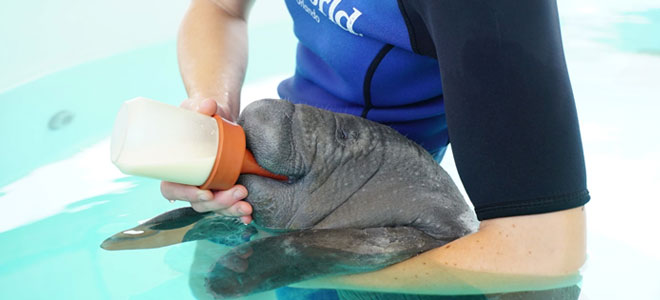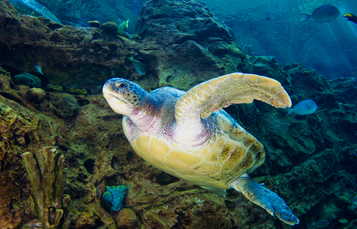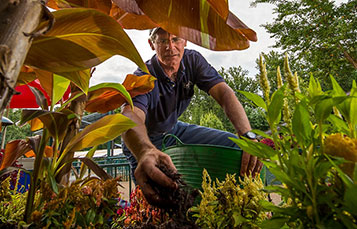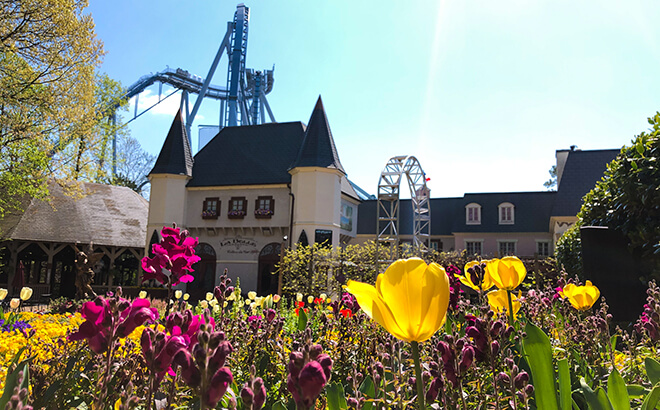10 Ways SeaWorld and Busch Gardens Celebrate Earth Day, Every Day (+ 3 Ways You Can Too!)
April 22, 2020Today the world is marking the 50th anniversary of Earth Day, but at our SeaWorld and Busch Gardens Parks we strive to celebrate and care for the planet every day. From eliminating plastic shopping bags and single use plastic straws and coffee stirrers to water conservation measures to ocean health; protecting animals and the wild wonders of the world depends on all of us working together. Check out these amazing stories from our parks and join us as we celebrate earth day each and every day!
That Papaya Tree Came from Where?
Busch Gardens Tampa Bay
Jody is a 31-year-old rhino at Busch Gardens Tampa Bay who loves papaya, and her love of this seeded fruit was very evident in the rhino poop that is a part of Busch Gardens’ composting efforts. In fact, over 3 million pounds of manure is recycled at the park’s state-certified composting site annually.
In 2018, animal care experts noticed a small papaya plant growing in the compost area. The seedling was relocated closer to Jody’s habitat, in the hope that it would one day grow into a fruit-bearing tree.
Two years later – the tree is thriving, offering Jody a delicious and nutritious snack!
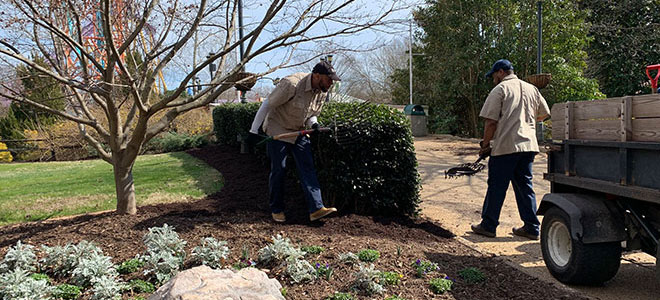
Using Real Christmas Trees as Mulch
Busch Gardens Williamsburg
Horticulture teams at Busch Gardens Williamsburg reuse the 1,400 real trees that adorn the park during the holiday season. Come January, the trees are transformed into hundreds of square yards of wood chips, used to mulch and nourish the park’s award winning landscaping. Many cities and towns around the country host similar “mulchfests” after the holiday season.
Did you know for 29 consecutive years Busch Gardens Williamsburg has been voted the World’s Most Beautiful Theme Park by the National Amusement Park Historical Association (NAPHA).
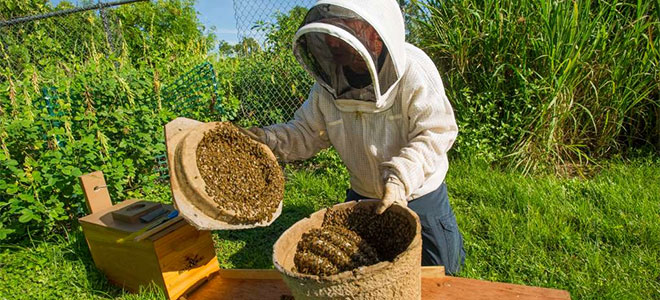
Using Honey to Help Heal Rescued Animals
SeaWorld Orlando
Florida’s beautiful year round flowers and sweet, sticky theme park treats provide the perfect haven for bees. Beginning in 2014, horticulture experts at SeaWorld Orlando, Aquatica Orlando and Discovery Cove began managing bees in a very different way, relocating them offsite, away from guests, team members and animals. These rescued bees now work to produce more than 400 pounds of raw honey each year, which veterinary teams use to help heal rescued animals, many which are threatened or endangered.
Honey has long been heralded for its antibacterial and anti-inflammatory properties, both for human and animals. It boasts antimicrobial properties, high levels of antioxidants and, when applied to the surface of a wound, it releases hydrogen peroxide to kill bacteria. Holistic practitioners consider the sticky stuff one of nature's best all-around remedies.
First-of-its-kind Biofiltration Aquarium System
SeaWorld San Antonio
In 2019, SeaWorld San Antonio unveiled Turtle Reef™, a 126,000-gallon coral reef-themed environment, featuring a biofiltration process that creates a near natural, environmentally based recirculating filtration system that attracts wildlife and reduces water and energy consumption in the park.
The biodynamic, multi-species environment is inhabited by rescued and non-releasable sea turtles in SeaWorld’s world-class care, including endangered green sea turtles, and Big Mama, a 250-pound loggerhead sea turtle rescued offshore in the Gulf of Mexico after sustaining significant injuries to her front and back flippers. Multi-colored fish also share this unique space.
This is the first time sea turtle species have been featured at SeaWorld San Antonio, giving guests the opportunity to learn more about some of the challenges facing sea turtles, and what we can all do to help protect them and their ocean home.
Rising Tide Conservation
SeaWorld San Diego
Inside SeaWorld San Diego, a research support aquarium is helping protect the world’s coral reefs one school of salt water fish at a time. How? Through its work with Rising Tide Conservation, which is dedicated to making breeding and rearing of marine tropical fish economically viable so as to encourage healthy coral reefs and their adjacent communities. Rising Tide Conservation has supported the successful aquaculture of nearly 30 species of marine ornamental fish and supports aquaculture research to develop techniques for raising marine ornamental fish for both public displays and aquarium hobbyists. These methods promote conservation and sustainability by providing relief to stressed reefs and the compromised fish populations that live there.
A team of aquarists at SeaWorld San Diego use techniques pioneered by Rising Tide Conservation to develop healthy and robust fishes that support the aquaculture of marine ornamental fish, including yellow tang.
Good-bye Plastic Bags and Straws
All 12 Parks
Starting In 2011, SeaWorld Parks began eliminating the use of plastic shopping bags in the park’s gift shops. Plastic bags are a huge problem for certain species of sea turtles, especially leatherbacks, which sometimes mistake the bags for jellies. Guests can purchase either a paper bag or reusable bag when purchasing items from the gift shops.
Shift from Styrofoam Dinnerware Products
All 12 Parks
In 2019 SeaWorld Parks furthered its commitment to protecting the environment by removing polystyrene foam dinnerware products, including bowls, plates and trays from the dining operations at all 12 of its parks and replaced it with products made from 100% recycled material. With millions of meals served in the parks each year, the removal of polystyrene foam products, which are not biodegradable, helps keep them out of local landfills, as well as in the ocean ecosystem.
Responsible Food Sourcing
All 12 Parks
SeaWorld is committed to providing guests with sustainably-sourced food, including cage-free eggs, certified organic coffee, locally sourced produce and sustainable seafood. The parks have also expanded the number of plant-based offerings on menus across our parks.
Animal Rescue and Rehabilitation
The celebration of Earth Day is 50 years old, but our parks have been helping animals in need for more than 55 years. SeaWorld and Busch Gardens are leaders in animal rescue, with a legacy of rescue work benefiting more than 36,000 ill, injured, orphaned or abandoned animals. Working in partnership with state, local and federal agencies, our Rescue Teams are on call 24/7, with a goal for every rescued animal to successfully be rehabilitated and returned to the wild.
The SeaWorld & Busch Gardens Conservation Fund
The SeaWorld & Busch Gardens Conservation Fund is a nonprofit foundation that has granted over $17.5 million in support of wildlife research, habitat protection, animal rescue and conservation projects around the world. Since its founding in 2003, the Fund has supported over 1,200 projects around the world. The Fund commits 100 percent of donations to on-the-ground wildlife conservation.
Looking for ways you can celebrate Earth Day in your home?
We've gathered a couple of ways that you can help show your love for our planet with some hands-on activities and more.
- Recycle paper at home with this DIY paper-making activity.
- Get tips on creating less waste and rich soil by composting.
- Show your coworkers and friends how you're taking a stand for the Earth with free virtual meeting backgrounds.







